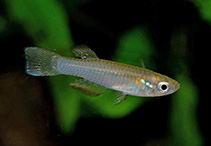| Family: |
Procatopodidae (African lampeyes), subfamily: Procatopodinae |
| Max. size: |
4.5 cm TL (male/unsexed); 4.5 cm TL (female) |
| Environment: |
benthopelagic; freshwater; pH range: 6.5 - 7.19999980926514, non-migratory |
| Distribution: |
Africa: upper Gambia, upper Bafing and upper Konkouré rivers in Guinea (Ref. 57259). |
| Diagnosis: |
Dorsal spines (total): 0-0; Dorsal soft rays (total): 7-9; Anal spines: 0-0; Anal soft rays: 14-17. Diagnosis: Robust, fairly deep-bodied ‘Lampeye’ species with relatively long fins; dorsal fin with 7-9 rays, anal fin with 14-17 rays; displacement between dorsal and anal fins 1/7-9; scales on mid-lateral series 26-29 (Ref. 57259).
Colouration: Male colouration: overall body colour is a light olive-grey, with a distinct light blue iridescence on the sides, mainly on the frontal part of the back, between the upper operculum and the beginning of the dorsal fin; all scales have a distinct dark brown border, creating a strong reticulation on the sides; the dorsal and anal fins are yellow to orange-red, this colour intensifying towards the fin margins; red-brown spots, arranged in curved bands, are present in the posterior parts of these fins; the caudal fin is pale blue in the central part, grading to yellow or orange towards the margin; this fin also displays a large number of dark brown spots, arranged to form crescent-shaped crossbars (Ref. 57259). Female colouration: translucent grey in general body colour with a weak silver iridescence; the scales also have narrow brown borders, but this feature is less distinct than on the male; the unpaired fins are colourless (Ref. 57259). Both sexes have a distinct light blue-green reflecting spot in the upper part of the iris (Ref. 57259). |
| Biology: |
Found in quiet parts of brooks, small rivers and streams under gallery forest cover in the savannah of the Fouta Dialon (Ref. 7372, 57259). Not a seasonal killifish. Is very difficult to maintain in aquarium (Ref. 27139). |
| IUCN Red List Status: |
Least Concern (LC); Date assessed: 23 April 2020 Ref. (130435)
|
| Threat to humans: |
harmless |
| Country info: |
|
Source and more info: www.fishbase.org. For personal, classroom, and other internal use only. Not for publication.

